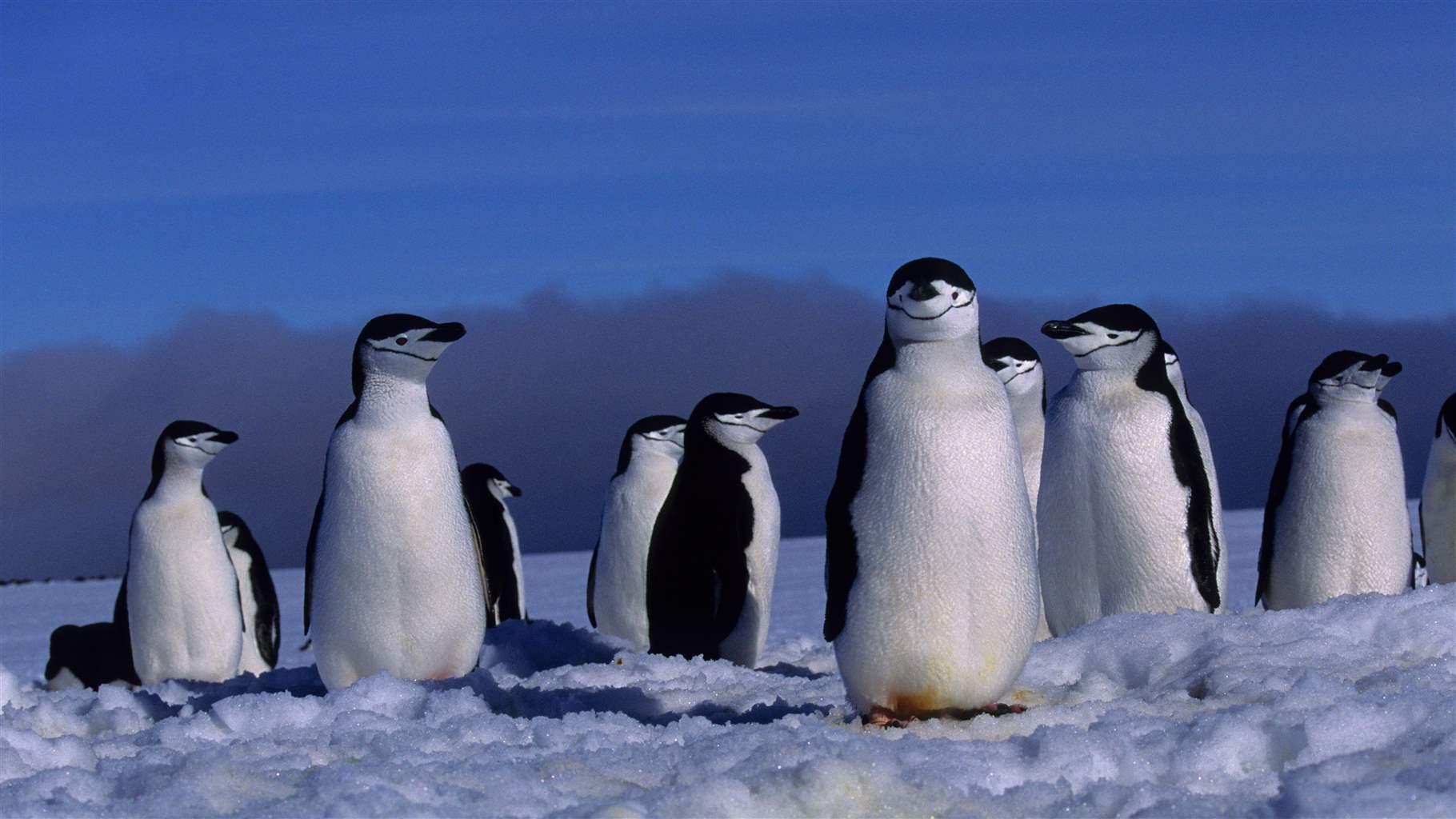New Penguin Research Shows Potential Overlap Between Foraging Areas and Commercial Fishing
Chinstrap penguins on South Sandwich Islands venture far to hunt, potentially into krill fishery

New research that charts the feeding habits of chick-rearing chinstrap penguins on the South Sandwich Islands raises questions about potential overlaps with areas open to commercial krill fishing. The data could help shape future management of the South Georgia and the South Sandwich Islands (SGSSI) Marine Protected Area (MPA), which, in 2023, is up for periodic five-year government review against its stated objectives.
The SGSSI MPA was established in 2012 and covers an area of 1.24 million square kilometres (479,000 square miles), including 283,000 square kilometres (109,000 square miles) of fully protected waters where all extractive activities, such as fishing, are prohibited. The protections were enhanced in 2013 and in 2018 following the first independent five-year review.
The South Sandwich Islands archipelago, located 760 kilometres (470 miles) southeast of South Georgia in the Southern Ocean, is one of the least disturbed marine ecosystems on the planet. Home to 10% of the world’s penguin population, these isolated volcanic islands host about 95,000 breeding pairs of macaroni penguins, more than 100,000 breeding pairs of Adélie penguins, and 1.3 million breeding pairs of chinstrap penguins.
Like other local predators, including humpback whales, chinstrap penguins consume vast volumes of krill. Novel research, led by the British Antarctic Survey (BAS) and funded in part by the Pew Bertarelli Ocean Legacy Project, studied the feeding habits of chinstrap penguins on the South Sandwich Islands using satellite-linked tracking tags over a 70-day period. The peer-reviewed findings were recently published in the journal Deep-Sea Research Part II: Topical Studies in Oceanography.
The researchers found that breeding chinstraps collectively consume 5,300 tonnes of krill per day during the brood stage, and 4,400 tonnes during the crèche phase, when fledglings group together for protection while both parents hunt for food. Each year an estimated 258,000 tonnes of krill are required to sustain parenting adults over the chick-tending period. Over the past decade, commercial krill catch in the southwest Atlantic has increased and is now above historic highs. The 2019-20 krill catch in the region totalled 450,731 tonnes—73% of the limit set by the Commission for the Conservation of Antarctic Marine Living Resources (CCAMLR), the governing body comprising 25 member countries and the European Union that is responsible for protecting marine life in the Southern Ocean.
Prior to this research, scientists knew little about the foraging habits of South Sandwich Islands penguins due to the remoteness and inhospitality of the site. Such information is crucial to preventing future competition with the Antarctic krill commercial fishery. Although the stormy waters surrounding the South Sandwich Islands have not been fished for krill in 25 years, the waters are allocated a CCAMLR quota of 93,000 tonnes—meaning that fishing could legally occur. The SGSSI government enforces marine management regulations under its own legislation, including for the SGSSI MPA. The MPA includes a closed area, which bans krill fishing and limits longline fishing for toothfish within 50 kilometres of each of the islands, and a seasonal summer fishery closure. The government included the closed area, which amounts to 51,000 square kilometres (19,700 square miles), as a precautionary measure to mitigate any potential competition between future krill fishing activity and krill-dependent predators.
As part of the research, BAS scientists equipped 20 chinstrap penguins in January 2020 with satellite-linked transmitters at breeding sites on Natriss Point, Saunders Island. Data from the transmitters was used to calculate what proportion of the chinstraps’ foraging activity occurred in areas where local regulations allow krill fishing (from 50 kilometres ((31 miles)) from shore out to 322 kilometres ((200 miles))—the boundary of the South Sandwich Islands’ exclusive economic zone ((EEZ)) ). Eleven of the 20 transmitters continued transmitting until the end of the chick-rearing period in late February. All transmissions ended at the end of summer in early March, when the trackers were lost during the penguins’ annual moult.
Over the 70-day tracking period, researchers recorded 388 trips using the Argos Platform Terminal Transmitters (PTTs) system. The study found that the birds made significant foraging trips, with an average maximum distance travelled from the colony of 28.9 kilometres (18 miles), with a few trips exceeding 50 kilometres (31 miles). (See Figure 1).
The preferred foraging habitat of chinstrap penguins, calculated from the tracking and habitat modelling, was within the 50-kilometre pelagic (31-mile) no-take zone around the islands. Researchers predicted that most foraging activity would occur within the bounds of the no-take zone during the chick-rearing period.
However, the authors found that the potential remains for overlap between chinstrap foraging and krill fishing grounds, which are open from May to September within the waters of the MPA. Although the spread of sea ice limits access to the southern waters of the South Sandwich Islands in the austral winter, chinstrap penguins north of the sea ice may still be vulnerable to competition if the fishery were to operate in these open water areas. Fishery managers should consider this data gap and other unknowns about krill abundance and distribution.
Because Pew Bertarelli Ocean Legacy, as part of the Great British Oceans coalition, believes that the waters surrounding the South Sandwich Islands merit full protection, we encourage the SGSSI government to manage these waters with precaution and consider further expanding the fully protected areas to the full extent of the MPA for South Sandwich Islands EEZ to comprehensivley protect the marine life and ecosystem.
Katie Gray is a senior associate and Johnny Briggs is a senior officer working on the Pew Bertarelli Ocean Legacy Project.













